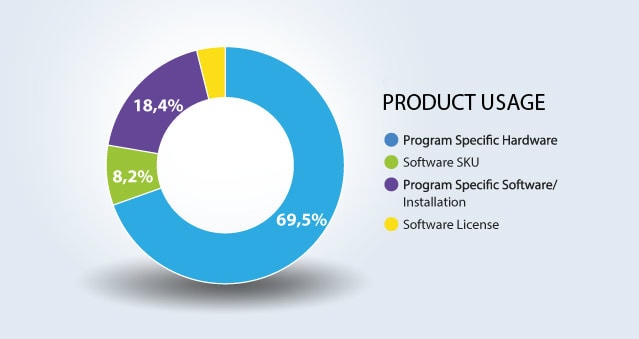The concept is simple. When you pay your utility bills – electric, gas, water – or even your mobile phone bill, you’re billed for what you used. For example, if you run an air conditioner during the summer months, your electric bill for those months is higher than in the winter. By the same token, if you use gas to heat your home your gas bill will spike in the winter. In essence, a consumption-based billing model allows customers to pay for only what they consume or use.
A Historical View of Payment Schemes
Traditionally, there have been two primary payment models – subscription and fixed pricing. Let’s take a look at each of these revenue models and dig a bit deeper into the makeup of consumption-based billing.
- Subscription billing: In its purest form, subscription-based billing provides customers with an all-you-can-eat flat rate pricing model. Since this model usually includes a monthly, quarterly, bi-annual or annual contract, it enables companies to build long-term customer relationships and provides them with a predictable revenue stream.
- Fixed pricing: This pricing model enables customers to pay a one-time fee for products and services. Since customers pay an established amount they benefit from price predictability, however businesses can find themselves at risk of undercharging.
While both of these payment models provide advantages and disadvantages, they were missing one thing – flexibility for both the customer and business. The more sophisticated consumption-based pricing scheme leverages the best characteristics of subscription and fixed billing and combines it with usage-based pricing to provide customers with more billing options, and enable businesses to create more innovative, effective and revenue-generating pricing packages. “I have witnessed significant increases in the revenue streams of many companies that have added consumption billing,” remarked Nathan Shinn, Chief Strategy Officer and Founder at BillingPlatform. “In telecom companies, metered usage still helps add a variety and differentiation to general subscription plans. I have seen media and transportation industries revitalize their customer base by simply charging per view or ride.”
“Firms are shifting from one-time perpetual sales or fixed monthly subscriptions to consumption models that blend one time, subscription, and usage-based billing.” – Forrester Wave
Inside Consumption-Based Billing
Gathering usage content for accurate billing can be complex. This is where you need powerful and intelligent billing capabilities to unlock the full revenue potential of your consumption-based pricing strategies. Consumption-based billing requires a billing system that provides the following core functionality:
- Product catalog: Design and deploy new offerings, manage existing ones, and customize offers by industry, target segment and region with a flexible product catalog.
- Data mediation: Transform data from any source with an automated, rules-based mediation engine that normalizes data, filters out unnecessary usage records, and routes information to be rated and billed.
- Rating engine: Ensure customers are accurately charged with a real-time rating engine that assigns charging rates to a usage event or call detail record (CDR).
- Invoicing: Support complex account hierarchies and increase billing accuracy with automated invoice processing.
- Reporting and business intelligence: Use reports and analytics to access granular billing data to uncover areas to reduce costs, increase revenue, and optimize billing performance.
It’s true, deploying consumption-based pricing schemes isn’t always easy. However, it provides a wealth of benefits you currently may be missing.
Consumption-Based Billing Advantages
Traditionally used by utility and telecoms companies, consumption-based pricing is gaining acceptance across a wide variety of industries. In recent years, companies like AWS, Uber, and Airbnb have joined a growing number of companies charging on a consumption basis. In fact, a recent Gartner report revealed that consumption-based pricing models are gaining acceptance by the IT user community both to conserve cash and to increase elasticity.
The flexibility of consumption-based pricing models allow companies to incorporate this pricing scheme in a variety of ways, like supplementing existing models with add-on features. By incorporating consumption-based billing into your pricing mix you can:
- Improve revenue streams by combining the predictability of subscription revenue with revenue gained from additional products, services and features
- Gain a competitive edge by delivering attractive offering packages and pricing options
- Improve customer satisfaction and boost customer loyalty by providing customers with more product, services and bundling choices, as well as payment options
- Bring new offerings to market faster by experimenting with different combinations of recurrent and consumption pricing models
- Reduce revenue leakage by tracking usage and executing metered billing
Consumption-based billing enables you to create the differentiated, flexible and personalized offerings that today’s customers not only desire but demand. However, capturing the benefits of consumption-based billing requires an intelligent billing system that delivers an unparalleled range of billing capabilities.
Capture the Benefits of Consumption-Based Billing
Meeting changing customer needs and preferences is never easy. And when it comes to billing, customers are increasingly looking for companies that offer value and price transparency. A consumption-based billing model enables you to meet customer requirements, while providing you with the flexibility needed to grow your customer base and increase revenue.
At BillingPlatform, we’re committed to helping you reach your consumption-based billing goals. Our flexible billing platform enables you to deploy any combination of one-time charges, subscription, consumption, or hybrid billing – on a single platform. We give you the power to develop even the most complex consumption-based pricing schemes to differentiate yourself from the competition and gain long-term competitive advantage. Still curious if consumption-based billing is right for you? Check out our whitepaper to learn more!



